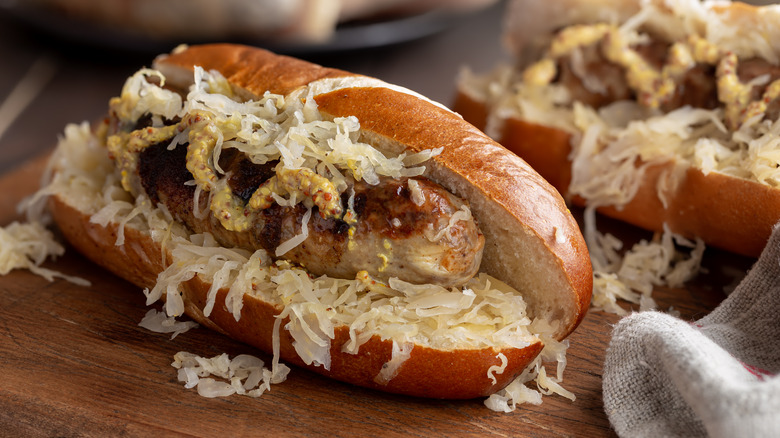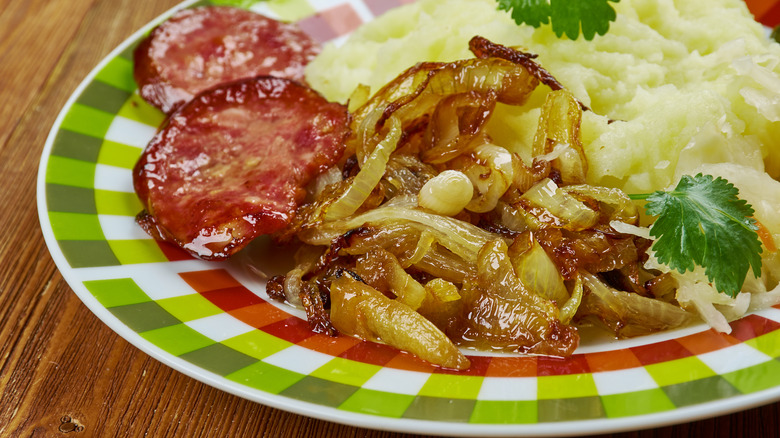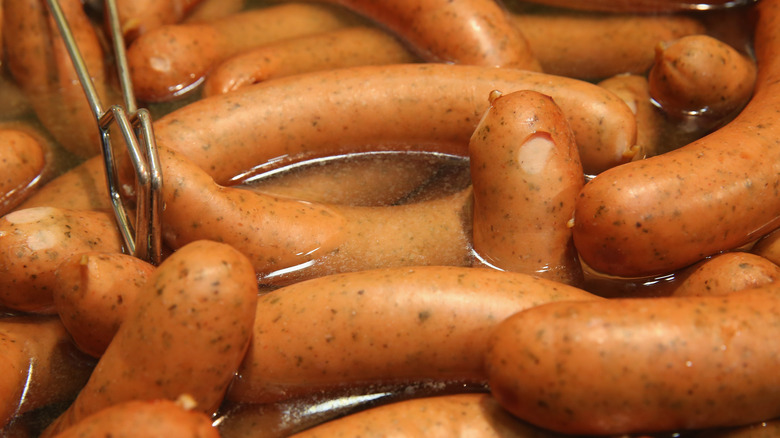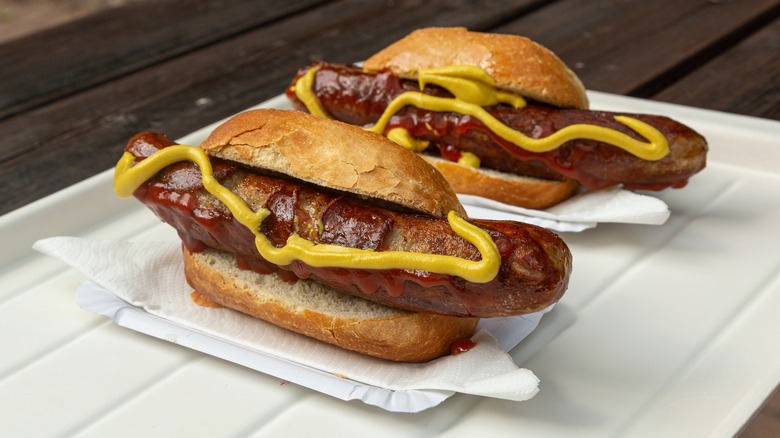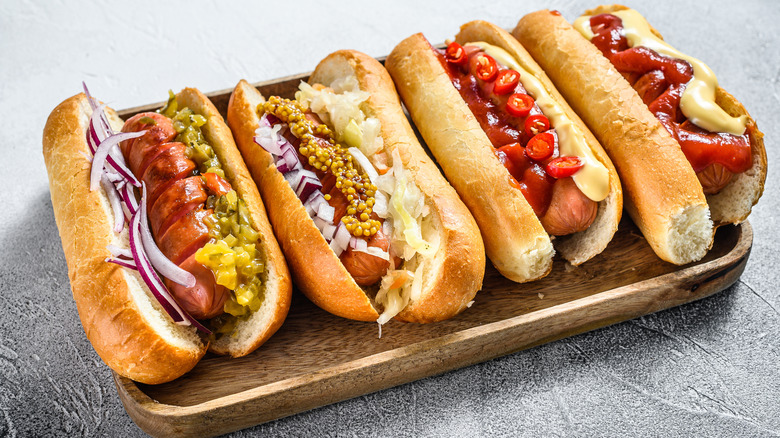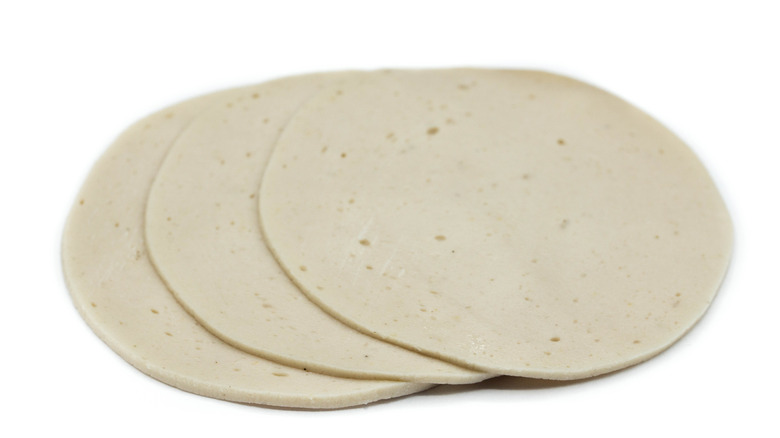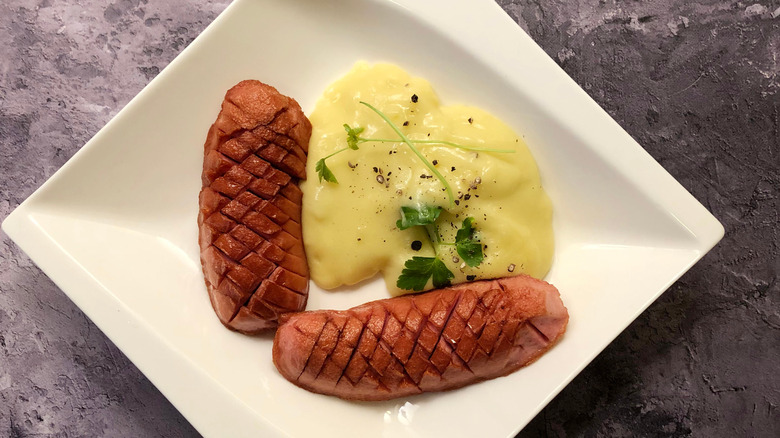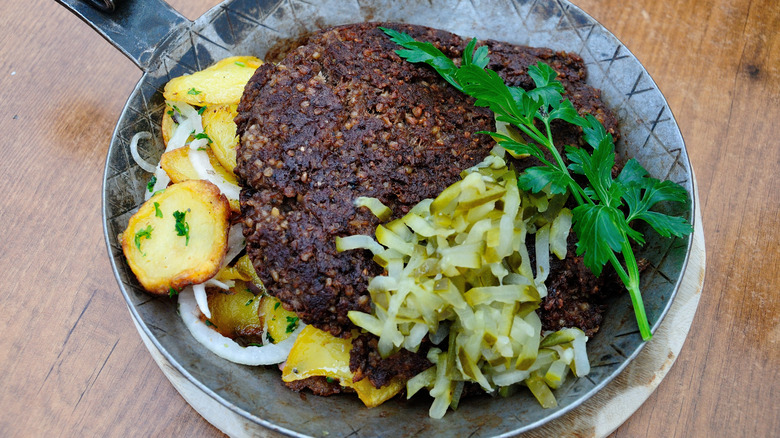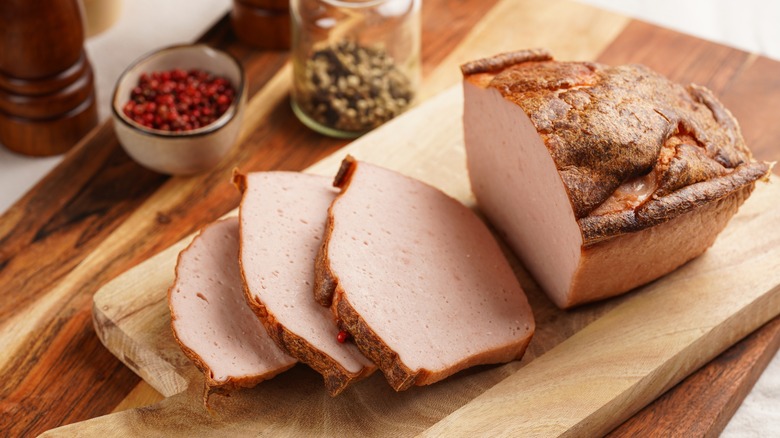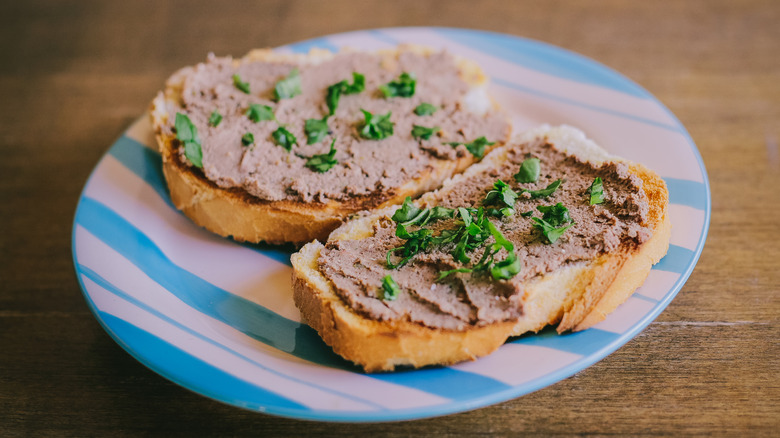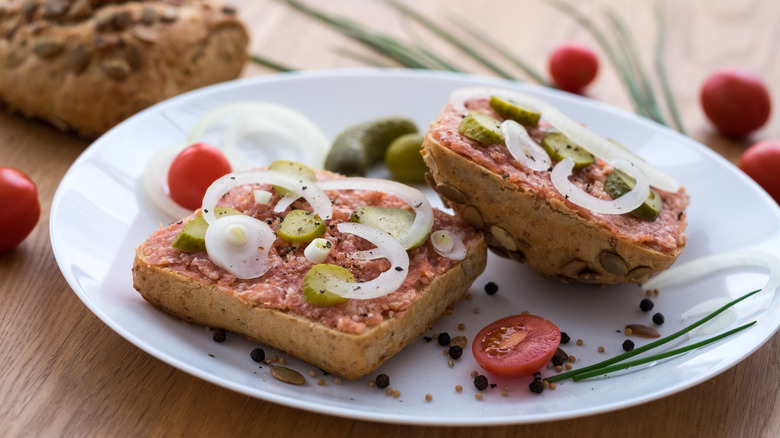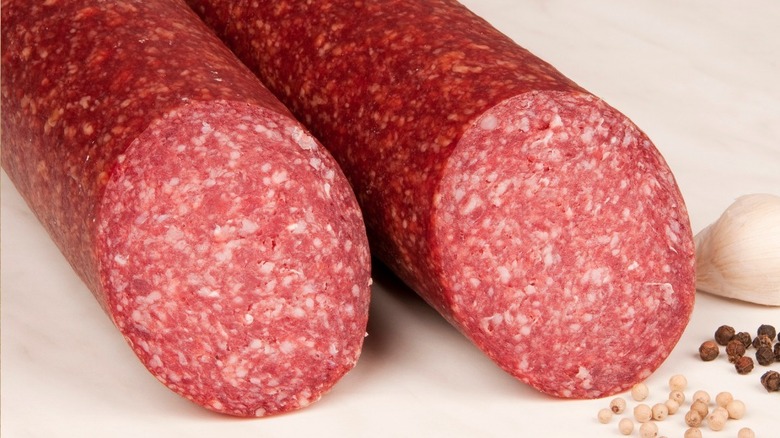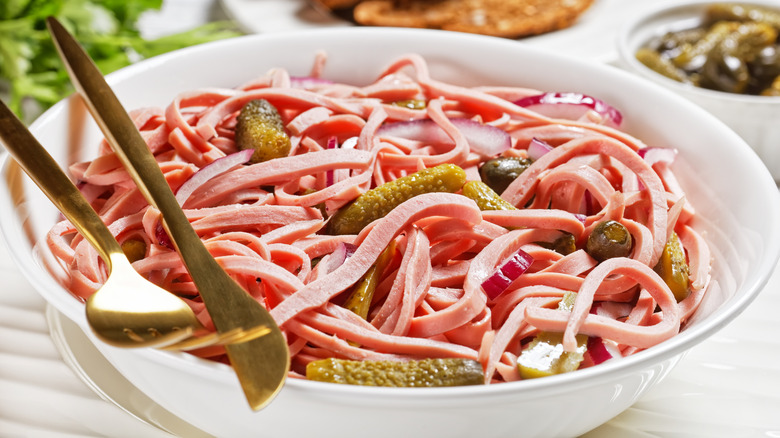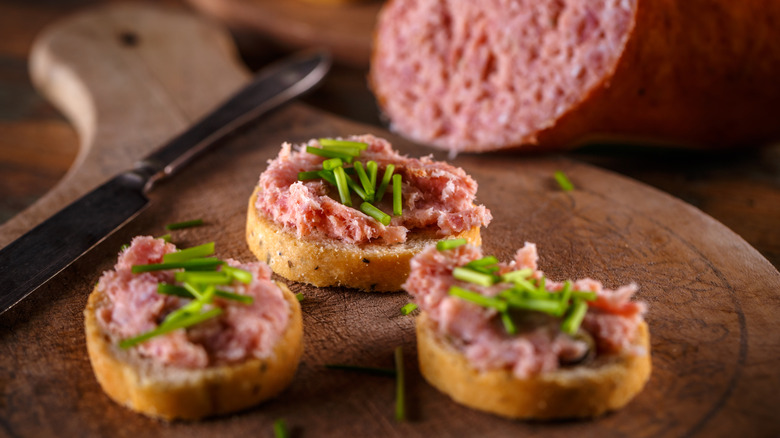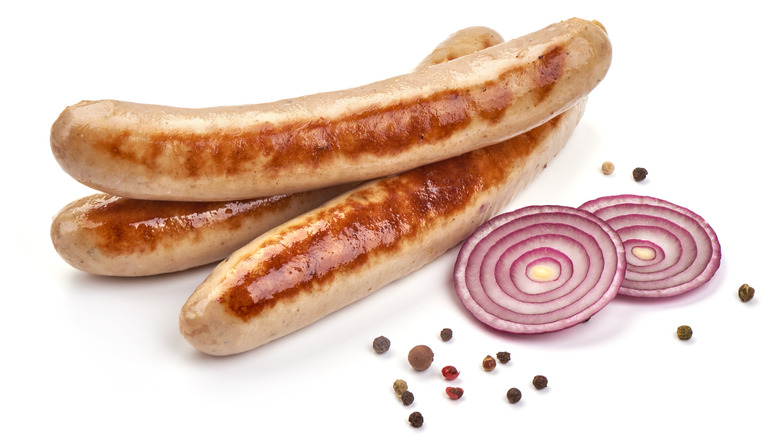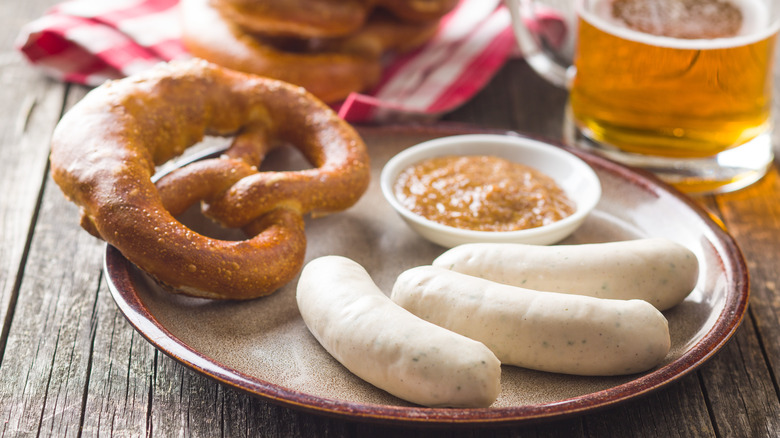15 Types Of German Sausages And How They Are Made
When you think of German cuisine, one item is bound to be at the top of the list: sausage. From brats to Frankfurters, Germans are known around the world for their love of sausage. And the two have a long history! Sausages alone have been around since at least 500 B.C., when they were the namesake of an ancient Greek play. Some say sausages have even been around for 5,000 years. They have made appearances in the Greek epic poem "The Odyssey" and a number of Roman texts.
Sausages have been an integral part of German cooking for countless centuries. Various spices can be added to create different flavors (per DutchTrans). Smoked and dried sausages can remain fresh for long periods of time, and it is believed that preservation is the reason sausages were invented in the first place.
Let's dive into the histories and makings of 15 popular German sausages.
1. Blutwurst
In case you hadn't guessed, "blut" is German for "blood," and "wurst" means "sausage." Yes, blutwurst is German blood sausage. While there are variations between regions that incorporate an array of different herbs and seasonings, each type of blutwurst has a few things in common. They are usually made from pork and make use of the meat, fat, and, of course, the blood. The meat often comes from less desirable cuts of the animal, such as the cheek, groin, lungs, liver, and snout (per Meats and Sausages). This makes blutwurst a pretty economical choice with little of the pig wasted.
According to Travel Food Atlas, blutwurst is one of the oldest kinds of sausage and is especially popular in Bavarian cuisine, in southeast Germany. The sausage is, unsurprisingly, red in color. Because it is cooked, it can be served as a cold cut, but it is often heated up and served alongside sauerkraut or potatoes.
2. Bockwurst
German pub owner Richard Scholtz invented bockwurst, now one of the most common sausages found in Germany, in 1889, as noted by TasteAtlas. It was served alongside bock bier (beer), a lager with a high alcohol content. Or so the story goes.
Bockwurst was traditionally made with finely ground veal and pork. Nowadays, it can be made using other meats, including fish in some areas. As with blutwurst, various seasonings can be added, but the most common are salt, white pepper, and paprika. The meat mixture is stuffed into a natural sausage casing then smoked.
Bockwurst is a great one for the grill, though you can enjoy these links any way you'd like. It is usually accompanied by yellow mustard and is enjoyed with bread, sauerkraut, and potatoes. It can also be served with eggs at breakfast. When enjoyed later in the day, try pairing it with a cold glass of German beer. The legend does say it was made for it.
3. Bratwurst
Bratwurst literally translates to "finely chopped meat sausage" in English. As with many other German sausages, the traditional meat of choice is pork, but nowadays other meats may also be used. Often you will find beef or veal mixed in with the pork along with a wide assortment of herbs and spices. A popular way to eat bratwurst is grilled then put in a roll or on a bun. Toppings include mustard, cheese, onions, and more. Bratwurst can be sold pre-cooked or raw.
According to the Bratwurst Museum in Muehlhausen, Germany, bratwurst dates back to a Roman cookbook in the first century B.C. And there are several different varieties of bratwurst, including Coburger, first appearing on a menu in 1498, and Nuremberg, first recorded in 1313. The Nuremberg sausage has protected geographical indication status, which means that Nuremberg sausages can only come from Nuremberg and be made according to the traditional recipe. Salt, pepper, and marjoram are the main seasonings.
4. Frankfurter Würstchen
Frankfurter Würstchen, or Frankfurter sausages, were created in the Middle Ages in Frankfurt, Germany. A court declared in 1929 (and later confirmed in 1955) that Frankfurter Würstchen is a protected name, and the sausages can only be produced in Frankfurt am Main. Made exclusively from pork using a sheep's intestine casing, Frankfurter sausages are usually boiled and served in pairs on a roll with mustard.
The very similar Wiener Würstchen (Vienna sausages) were created by a butcher from Frankfurt, Johann Georg Lahner, in 1805 in Vienna. He altered the traditional Frankfurter Würstchen recipe by adding beef. Vienna sausages are also traditionally served in pairs. Like the Frankfurters, Wieners can be served with a roll and potato salad or used in dishes such as soup or pasta salad.
Americans might recognize the names frankfurter and wiener as alternative names for hot dogs. German immigrants brought these sausages with them when they moved to the U.S. in the 19th century where they were first called "dachshund sausages," which evolved into "hot dogs."
5. Gelbwurst
Gelbwurst translates to English as "yellow sausage," but while the color is quite pale when compared to other sausages, it is not yellow. When only pork is used, the color is almost white. If beef is mixed in, then the color takes on a more grayish tone. The meat used is lean, and some spices, such as ginger and cardamom, are used for flavoring. Gelbwurst is low in both fat and salt. A specialty of Bavaria, gelbwurst is sliced thinly and eaten as a lunchmeat. Children especially are fans.
The first mention of gelbwurst was in 1905 when it was called "brain sausage" because the recipe called for up to 25% brain meat. Saffron was used to color the casings, which led to the name changing to yellow sausage. Today's artificial casings are sometimes dyed yellow and must be removed before eating the sausage. Gelbwurst, which is boiled, only remains fresh for a few days in the fridge, so it must be consumed soon after purchasing.
6. Knackwurst
Native to northern Germany, knackwurst (often spelled knockwurst in English) is a smoked sausage similar to bratwurst but with some key differences. The meat in knackwurst is a blend of veal and pork and of a different grind than bratwurst. Knackwurst is also more heavily spiced, and the links are shorter and fatter.
Unlike other sausages on this list, knackwurst is not usually served on a roll or bun. Instead, it is the star of the plate and accompanied by side dishes such as sauerkraut, potato salad, vegetables, or beans. Because it is only smoked, knackwurst must be cooked before consuming. They are great on a grill, fried in a pan, or boiled. According to Brats and Beer, knackwurst was served at the very first Oktoberfest in 1810 in a stew, but this way of preparing it is no longer common. Of course, that needn't stop you from trying different ways of enjoying this popular German sausage.
7. Knipp
Not the most attractive of sausages, knipp was once a common food for poor people who needed to stretch their limited meat supply and didn't have the funds for finer cuts of pork or beef. TasteAtlas specifically names peat diggers as large consumers of knipp. Now it is a specialty of the northern German town Bremen and the surrounding area. Traditionally knipp was made from butcher scraps mixed with hulled oats and herbs.
Knipp comes in smoked rolls that are around four inches thick. The meat is usually a blend of pork and beef. It is sliced and fried in a pan before being served alongside such traditional German side dishes as boiled or fried potatoes, gherkins, applesauce, and bread. Knipp is also sometimes pan fried in butter and served on toast or a slice of bread. Which would make for a pretty hearty breakfast! If not the most appetizing to look at.
8. Leberkäse
Leberkäse literally means "liver cheese," which is probably the least appetizing name for a meatloaf we have ever seen. Despite "leber" meaning "liver," the name of this German sausage is thought to come from the Middle High German word "laib," which means "loaf," and not the modern word for liver at all. The cheese part likely refers to how the dense loaf is cheese-like in consistency and that it can be used in similar ways to cheese. Put a slice of leberkäse on a sandwich or toast, for example.
Unlike the meatloaf you will find in North America, leberkäse is finely ground and may or may not contain liver. In Bavaria, it is more common to find leberkäse made from bacon and corned beef. Whatever the meat used, it is ground together with onions to a smooth consistency then pressed into a loaf pan and baked. Like knipp, meatloaves are a great way to use meat scraps that would otherwise go to waste.
9. Leberwurst
This "leber" sausage does have liver in it. Leberwurst is, of course, liverwurst. The livers of pigs or calves are used, but other organ meats may also be mixed in. Which seasonings are used varies by region.
There are two main kinds of leberwurst, sliceable and spreadable. Both are used on sandwiches, in stews, and in any other way you would use a spreadable food or sliced sausage. The spreadable leberwurst can be made into a dip with mayonnaise for bread or crackers, and sliced leberwurst can be pan-fried with onions. Organ meat is highly nutritious, but it's not something most of us eat in high quantities. So hiding it in a casing mixed with herbs and spices is one way to disguise liver's strong and distinct flavor.
US Wellness Meats points out that leberwurst is sold fully cooked and will only last a few days in the fridge. So if you want to give leberwurst a try, have a plan before purchasing.
10. Mettwurst
Mettwurst is minced pork sausage, though some recipes also call for veal or beef to be mixed with the pork. The meat is seasoned with salt and pepper. Sometimes ginger, mustard seeds, paprika, marjoram, caraway seeds, coriander, allspice, or cardamom are also added, giving the sausage a strong flavor. Put into a natural casing and made into links, mettwurst is cured and then often smoked. The longer it cures, the firmer the sausage.
Mettwurst is not typically cooked after it has been smoked, and the softer, less cured, variety is spreadable. It's a perfect pairing for sliced bread or crackers. The firmer mettwurst can be tossed on the grill, baked in an oven, fried in a pan, or put into a stew like many other sausages on this list. Regardless of which type you choose to eat, mettwurst can be served alongside potatoes, sauerkraut, salad, and other traditional German side dishes.
11. Plockwurst
Plockwurst is a dry-cured, firm, raw sausage with a coarse grind. Many believe the name comes from the traditional way the sausage was cut before modern technology made the process easier and more efficient. The meat was minced by hand on a large block, or "plock" as it was called in some areas.
Unlike many of the other sausages on this list, plockwurst's chief meat is beef, though pork may be added. Due to being fermented, smoked, and then dried for over a month, plockwurst is more shelf stable than other sausages. Once it is sliced, however, it should be refrigerated and polished off within a week.
Because it is quite similar to salami, plockwurst can be used in the same instances you would use salami. It's great sliced up in sandwiches and even as a pizza topping. One plockwurst fan suggests eating it with a dark, flavorful bread such as pumpernickel.
12. Regensburger wurst
Regensburger wurst, a lean pork sausage, originated in the city of Regensburg, Bavaria in southeastern Germany in the late 1800s. Today, it is a protected name, and only sausage made in Regensburg and its surrounding area can be considered "Original Regensburger Wurst." After the meat and seasonings are blended, they are put into a natural casing and smoked over beech wood.
Eaten hot or cold, Regensburger wurst make a great snack due to their small and squat size. It is the key ingredient in Regensburger wurst salad. The cut-up sausage is topped with a mixture of vinegar, oil, chopped onions, and mustard. There is also the Regensburger Bemmel, a sandwich of halved and fried Regensburger wurst links, sweet mustard, horseradish, and sliced gherkins. Of course you can also go with the traditional sauerkraut and fried potatoes to round out this popular Bavarian meal.
Be sure not to let these sausages sit in the fridge for too long, even an unopened package.
13. Teewurst
Another popular spreadable German sausage is teewurst (literally tea sausage). It has traditionally been associated with afternoon tea, or Kaffee und Kuchen (coffee and cake), hence the name. Yes, "kaffee" means coffee in English, but in the northern regions of Germany, tea is the drink of choice at this midday meal. Originating in what is now Poland in the late 1800s, the recipe for this fermented sausage was brought to western Germany when its manufacturers fled their homeland during World War II.
Teewurst is made from pork or a mix of beef and pork and some spices. It is firm but still spreadable, and although it is uncooked, it is safe to eat. The high fat content is what makes it so spreadable. Teewurst is enjoyed spread on crackers or slices of bread. It now comes in two grinds, coarse and fine, and can be found in plastic tubs as well as sausage casings.
14. Thüringer Rostbratwurst
Thüringer Rostbratwurst originated in Thuringia, a central German state located north of Bavaria. Within the region, different spices and seasonings are used, and the grind can be coarse or fine. Because they are sold raw, the seven or so inch long sausage links are traditionally grilled, and served on a bun with or without mustard (per Home Kitchen Talk). It is never served cold.
Thüringer Rostbratwurst is one of the most popular sausages in Germany, and in 2002, it was given European PGI protection. Reports vary, but it is believed the recipe dates back to the 1400s when "pure, fresh" pork was the only meat allowed. Nowadays, it is not uncommon to find a blend of pork and beef or veal. The flavor is spicy and a little bit tangy. It goes well with German potato salad and beer. In fact, sometimes beer is brushed on the sausages while they are being grilled for added flavor.
15. Weißwurste
Weißwurst, or weisswurst, translates literally to "white sausage" and was created in Munich, a city in Bavaria, allegedly by accident. On February 22, 1857, butcher Sepp Moser ran out of the usual sheep casings for his sausages and substituted with pork casings. To keep the unfamiliar sausages from bursting when fried, he boiled them instead.
Lean veal and bacon are blended with an assortment of seasonings, such as parsley, lemon, mace, onions, ginger, and cardamom. After cooking, the color can be a slightly off-white color (per German Culture), though restaurant owner Sepp Kraetz insists in World Hum, "It should be white as snow." Only the small pieces of parsley should be visible through the casing. The casing itself must be removed before eating.
Because weißwurst is not smoked, it spoils quickly. Traditionally, these sausages were made in the morning and eaten before noon to avoid this problem. This custom is still largely followed even in these modern days of refrigeration.
